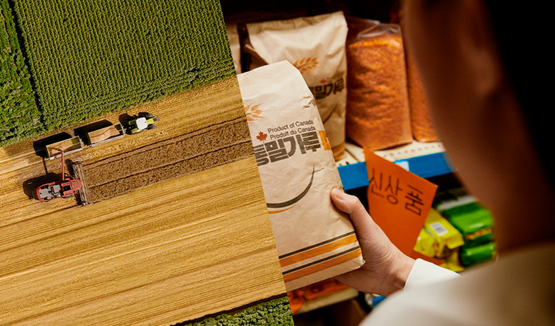
Agri-food
With its huge population, Asia is a critical market for Canadian agriculture. Our agri-food products and innovation can help the region’s growing middle class meet its food and nutrition needs.
Insights and analysis from EDC to help plan your global expansion in the Indo-Pacific and Asia.

On this page
Rapid economic expansion. Massive infrastructure projects. Billions of potential customers, including an emerging middle class seeking new products and services. For these reasons and more, the Indo-Pacific region has become a key destination for Canadian businesses seeking trade diversification opportunities.
Indo-Pacific is home to some of the fastest-growing economies in the world—with demand to match. Collectively, it’s the second-largest trading bloc for Canadian goods and services, with China, Japan, and South Korea ranking among Canada’s Top 10 export destinations.
The region’s sheer size means there’s untapped potential for Canadian exporters. Both the Government of Canada and Export Development Canada (EDC) have made it a priority to increase Canadian trade and investment in Asia and Indo-Pacific, as the region’s diverse and growing markets offer compelling opportunities across key sectors.
But it’s complex, and inexperienced exporters face many potential pitfalls.
With careful planning, the right partners, and a willingness to commit for the long term, a venture in Indo-Pacific may be the catalyst for your company’s global growth.
Plus, you don’t have to go it alone. EDC is here to help Canadian companies experience the export impact by expanding globally and diversifying beyond Canada’s traditional trade markets. With trade representatives across Asia, EDC can advise you on your Indo-Pacific strategy, connect you to our powerful network of partners and resources, and fuel your expansion with a full suite of financial and risk management solutions.
Which market in Asia and Indo-Pacific is the best fit for your company’s strategy and capabilities? There are dozens of options, but EDC market intelligence sees exciting potential for Canadian exporters in the following countries.
Canadian companies seeking a gateway to Asia should take a close look at Singapore. Home to 6 million people, this small-but-mighty island nation is the wealthiest in Southeast Asia, with an advanced economy specialized in finance, services, electronics and high-tech exports.
Singapore is an ideal choice for a regional base or branch in Asia because of its:
Singapore is also a leading transportation and logistics hub, with a seaport that links to 600 ports in 120 countries, and Changi Airport, consistently ranked as one of the world’s best—and busiest.
Canadian companies operating in Singapore can leverage the country’s free trade agreements, including the Regional Comprehensive Economic Partnership (RCEP), to access additional markets in Southeast Asia and the broader Indo-Pacific region.
Many Canadian companies are capitalizing on opportunities in Singapore. In the past five years, Canadian merchandise exports to Singapore have averaged about $1.3 billion, placing it in our Top 30 export destinations by value.
According to the Trade Commissioner Service (TCS), there’s still significant untapped potential for Canadian companies, including small- to medium-sized enterprises (SMEs), in agri-food and seafood, cleantech, fintech, and life sciences, among other sectors.
Source: Haver Analytics, EDC Economics
As a stable, open and mature economy with strong political and cultural ties to Canada, Australia is a great choice for companies seeking a comfortable entry point to the Indo-Pacific region.
Canada and Australia share a diversified commercial relationship, with significant two-way investment and trade in services. Canada exports about $2 billion worth of goods to Australia every year.
Our free trade agreement with Australia, the Comprehensive and Progressive Agreement for Trans-Pacific Partnership (CPTPP), has further opened the Australian market for Canadian companies by:
This strong foundation can support significant growth for Canadian businesses seeking to diversify. Currently, sectors of opportunity in Australia include infrastructure, power and renewables, digital industries and advanced technologies, along with agri-food, seafood and value-added wood products.
Source: Haver Analytics, EDC Economics
India is a priority market for Canada due to the scale of export opportunity it presents. One of the world’s largest emerging markets, India is home to more than one billion people, including a growing middle class ready to flex its purchasing power.
Canada has a longstanding and positive commercial relationship with India, and rich interpersonal connections woven by the large community of Canadians with Indian heritage. In 2023, India was Canada’s 8th-largest export market. Despite this, Canadian goods exports to India are still below where they could be—underlining the market’s untapped potential for Canadian businesses.
Canadian companies interested in India should be prepared to take on its challenges. With its enormous population and large land mass, India isn’t one market, but many. Personal relationships are key, so working with Indian partners can often help Canadian companies navigate the culture and develop strategies that will work in India to reduce the time needed to establish yourself in the market.
The business environment is competitive and price-sensitive, so careful market research is a must. Additional challenges include bureaucracy, underdeveloped infrastructure, lingering ESG issues and tariff barriers.
But the country is actively transforming its business environment to make investment and trade more attractive. While Canada doesn’t have an FTA with India, the two governments are working toward a Comprehensive Economic Partnership Agreement and a Foreign Investment Promotion and Protection Agreement (FIPA).
Sectors where Canada has a comparative advantage for exports include renewable energy and cleantech, infrastructure, agri-food and fertilizers.
Source: Haver Analytics, EDC Economics
A powerhouse within the Association of Southeast Asian Nations (ASEAN) and president of the G20 for 2022, Indonesia has cemented its status as a top emerging market for exporters and investors.
An improved business climate and favourable demographic trends are driving opportunities in Indonesia, which is already Canada’s largest export market in ASEAN. Indonesia’s population is the fourth largest in the world, and almost 25% percent of its 280 million people are middle class, creating demand for a wide range of goods and services.
After decades of underperformance, the Indonesian economy is beginning to reach its full potential, with a compounded annual growth rate of nearly 8% forecast for the next few decades. The Indonesian government is investing heavily in infrastructure, including public transport, airports and utilities. This opens opportunities for Canadian manufacturing, infrastructure and cleantech companies that can devote the necessary time and resources to build local relationships and conduct strong due diligence prior to entering the market.
Source: Haver Analytics, EDC Economics
With an annual gross domestic product (GDP) of US$1.8 trillion, South Korea is the fourth-largest economy in Asia, and one of the region’s most favourable business environments. Its combination of high growth and stability makes South Korea an appealing market for Canadian exporters and investors in many sectors.
The Canada-Korea Free Trade Agreement (CKFTA), signed in 2015, cemented South Korea’s status as a strong trade partner for Canada. In 2023, Canada exported almost $7 billion of merchandise to Korea. As bilateral trade increases, new opportunities are opening for Canadian companies in agri-food, seafood, cleantech and high-tech goods.
Recently, Korea has emerged as an entertainment powerhouse that’s producing shows, music, fashion and digital games popular across the globe. Thanks to the country’s robust information and communication infrastructure, network connectedness, and a culture that embraces early adoption, Korea is a leading market for virtual reality (VR) and emerging digital technologies.
Along with our traditional exports, significant opportunities exist for wireless technologies and network services, game development and digital entertainment companies.
Source: Haver Analytics, EDC Economics
EDC maintains detailed risk ratings on 48 countries, including major markets in the Indo-Pacific. Create a MyEDC account to access the Country Risk Quarterly report.
By 2040, the Indo-Pacific is forecast to account for 50% of global GDP and 40% of global consumption. As a high-growth region, it’s a promising destination for Canadian companies seeking to diversify beyond North America and expand to new global markets. Demand for a variety of Canadian goods and services is strong, and investment opportunities are plentiful.
Succeeding in Asia requires careful planning and long-term commitment. The business environment is complex and highly competitive. Canadian companies should be prepared to encounter challenges due to distance, language and culture, ESG concerns, and the local business environment while doing business in Asian markets.
EDC market intelligence sees alignment between regional demand and Canadian capabilities in the following sectors:

With its huge population, Asia is a critical market for Canadian agriculture. Our agri-food products and innovation can help the region’s growing middle class meet its food and nutrition needs.

Countries across the Indo-Pacific are making massive infrastructure investments to support economic growth, power digital transformation, provide new services and address climate change.

Canadian capital, expertise and cleantech innovations are in demand as Asia attempts to urbanize and industrialize in a sustainable manner, and to meet its net zero commitments.

The region is fast to adopt new technologies for manufacturing and digital transformation, which creates opportunities for Canadian innovation.
Finding new customers, suppliers and partners, understanding the local business culture and trade laws, and working out the logistics of shipping your goods are just a few of the challenges of doing business far beyond our borders.
But you don’t have to go it alone.
Canada has a network of trade-related organizations that work together to help you do business internationally. Working with Trade Commissioner Service’s officers abroad, EDC can connect you with reputable and vetted local agents, distributors, lawyers, accountants, translators, cultural and linguistic interpreters, customs brokers, government representatives and potential buyers throughout Asia and the Indo-Pacific.
We also offer solutions for financing, managing risk and growing working capital to help Canadian companies do business globally.
Learn more about how EDC can accelerate your business in the Indo-Pacific.
EDC’s branch office in Singapore is a gateway to Asia for Canadian exporters. We leverage our proximity to Asian buyers to identify new opportunities for Canadian businesses, connect with local partners, provide underwriting and financing solutions to facilitate trade, and act as a catalyst to increase Canada’s trade in the region. The office is also a service hub for our network of trade representatives across Indo-Pacific.
Get the latest market intelligence to manage trade volatility and tariffs and find opportunities for growth.
CPTPP is a free trade agreement (FTA) between Canada and 10 countries: Australia, Brunei, Chile, Japan, Malaysia, Mexico, New Zealand, Peru, Singapore and Vietnam. This huge economic bloc has a combined GDP of C$13.5 trillion and contains 495 million potential customers.
Once fully implemented, CPTPP will eliminate or sharply reduce tariffs among the member countries, opening markets for Canadian exporters and creating new procurement opportunities for Canadian companies.
Some Canadian goods such as fish, seafood and forest products can already enter CPTPP markets duty-free. The agreement also includes rules that create a consistent, transparent and fair environment for business and contains language that reflects Canada’s commitments to progressive ESG practices.
The CKFTA is Canada’s first FTA with an Asian country. It provides Canadian exporters with preferential access to the world’s 11th-largest economy, which is the fourth-largest in Asia.
Since 2017, 93% of Canada’s exports have had duty-free access to Korea, and by 2032, the CKFTA will eliminate tariffs on virtually all trade between Canada and Korea.
The agreement also increases market access opportunities across all sectors and strengthens protection for two-way investment, reduces non-tariff barriers and makes it easier for businesspeople to move between the two countries.
Developed with EDC, the TCS’s comprehensive directory of key ecosystem partners helps exporters de-risk the market and succeed in India.

Discover how naturSource successfully expanded to the Indo-Pacific region and elsewhere.

Discover opportunities and advantages for Canadian companies doing business in Thailand.

Expanding Canadian trade in the Indo-Pacific region

Get in touch with EDC. Find out more about how we can help you confidently enter new markets, reduce financial risks and grow your business by sending us a question. Or call us at 1-800-229-0575 on weekdays between 8 a.m. and 8 p.m. ET. Get started